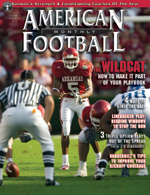Article CategoriesAFM Magazine
|
Strength Report - CITADELíS OFF-SEASON STRENGTH & CONDITIONING PROGRAMby: Donnell BoucherS&C Coach, The Citadel © More from this issue The winter off-season is the first of two primary development phases in the annual layout of a collegiate football player. The second is the summer. These are the only two periods of the year where no football is being played and training sessions are directed by the strength and conditioning staff. For us at The Citadel, the winter differs slightly from the summer, in terms of our priorities and where they rank. We believe that the better we keep the team physically prepared over the course of the training year, the better our athletes will retain training residuals from season to season, and arrive at camp in a more capable athletic state. However, due to the amount of time before the upcoming season, we reposition our immediate priorities: A Shift in Priorities
|
Copyright 2025, AmericanFootballMonthly.com All Rights Reserved | ||||||||||||||





